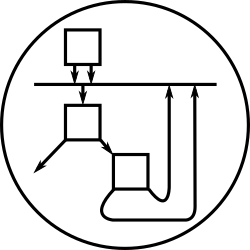Your very own 32-way SIMD machine
This page is a mirrored copy of an article originally posted on the (now sadly defunct) LShift blog; see the archive index here.
Mon, 15 October 2007
What’s a good way of counting the number of bits set in a word? The obvious answer, adding the low bit to an accumulator, shifting right, and repeating, is O(n) in the number of bits in the word. This is a sequential approach - and we can do better, complexity-wise, by using a parallel algorithm. Let’s assume we are using 32-bit words, and that Xn is just such a 32-bit word:
X0 = input word X1 = (X0 & 0x55555555) + ((X0 >> 1) & 0x55555555) X2 = (X1 & 0x33333333) + ((X1 >> 2) & 0x33333333) X3 = (X2 & 0x0F0F0F0F) + ((X2 >> 4) & 0x0F0F0F0F) X4 = (X3 & 0x00FF00FF) + ((X3 >> 8) & 0x00FF00FF) X5 = (X4 & 0x0000FFFF) + ((X4 >> 16) & 0x0000FFFF) total number of set bits = X5
This algorithm is O(log2 n) in the number of bits in a word.
Every ordinary N-bit-word based sequential machine is a disguised N-way, 1-bit SIMD machine with a slightly odd instruction set. Lots more on data-parallel algorithms here.
What about finding which is the highest bit set in a word?
X0 = input word X1 = X0 or (X0 >> 1) X2 = X1 or (X1 >> 2) X3 = X2 or (X2 >> 4) X4 = X3 or (X3 >> 8) X5 = X4 or (X4 >> 16)
… and feed X5 through the parallel counter-of-set-bits algorithm above. The resulting number is the index of the highest set bit in the original word, starting from zero.
Comments
On 15 October, 2007 at 12:14 pm, wrote:
On 15 October, 2007 at 12:54 pm, wrote:
On 15 October, 2007 at 1:12 pm, wrote:
You also might like Bit Twiddling Hacks, which includes the above and more.
On 15 October, 2007 at 1:14 pm, wrote:
The population count from the “Aggregate magic page” is a bit smaller:
from: http://aggregate.org/MAGIC/
unsigned int ones32(register unsigned int x)
{
/* 32-bit recursive reduction using SWAR…
but first step is mapping 2-bit values
into sum of 2 1-bit values in sneaky way
*/
x -= ((x >> 1) & 0×55555555);
x = (((x >> 2) & 0×33333333) + (x & 0×33333333));
x = (((x >> 4) + x) & 0×0f0f0f0f);
x += (x >> 8);
x += (x >> 16);
return(x & 0×0000003f);
}
And their most significant 1 bit is too:
unsigned int
msb32(register unsigned int x)
{
x |= (x >> 1);
x |= (x >> 2);
x |= (x >> 4);
x |= (x >> 8);
x |= (x >> 16);
return(x & ~(x >> 1));
}2
On 15 October, 2007 at 7:54 pm, wrote:
For x86 processors finding the first and last bit is best done with the BSF (Bit Scan Forward) and BSR (Bit Scan Reverse) instructions. They are quite fast on Intel (2 µops), but takes 20+ cycles on AMD, still it has to be a lot faster than the C routine.
On 15 October, 2007 at 11:29 pm, wrote:
Tony, that’s both completely messed in the head and cool.
On 11 November, 2007 at 10:06 am, wrote:
Hi Tony,
There is another way to find the highest bit set: convert the number to a float and inspect the exponent.
This is folklore, but explicitly mentioned in footnote 3 on p. 2 of van Emde Boas tree data structure
Cheers,
Sebastian.

The link to the pdf from the LtU node is broken, and I can’t find the paper on citeseer. It is available to ACM members from http://portal.acm.org/citation.cfm?id=7903